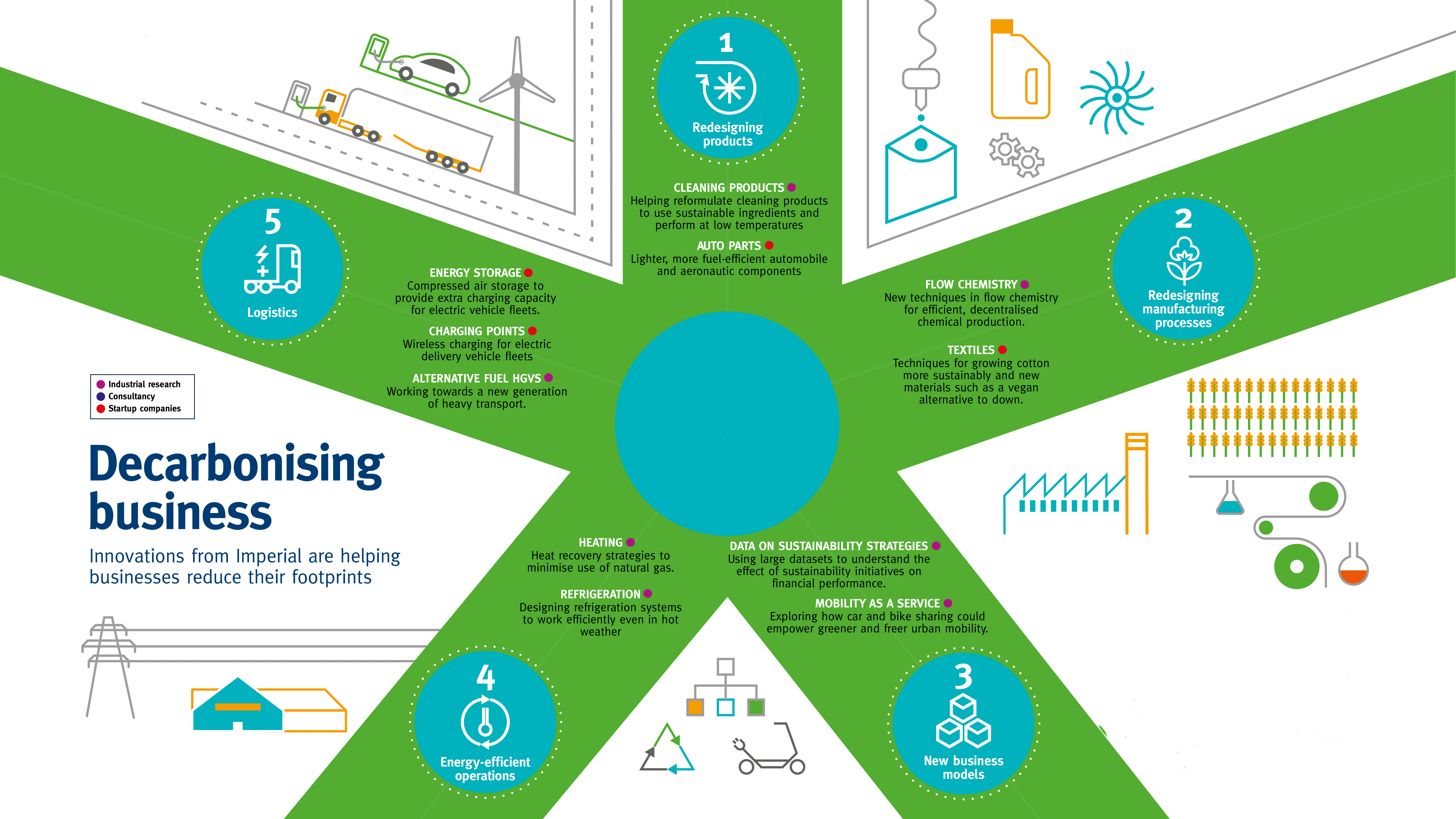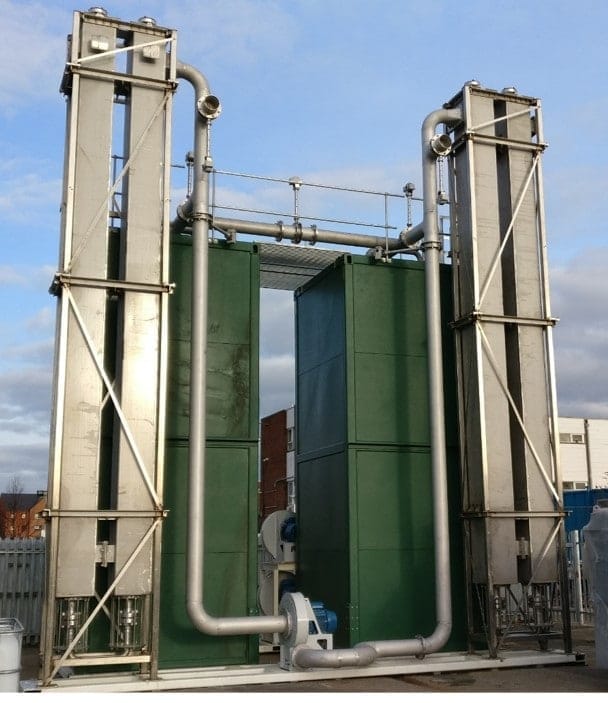Leading Strategies Corporations Employ for Decarbonization
From redesigning products to embracing renewable energy and implementing circular business models, companies are undertaking multifaceted approaches to reduce their carbon footprint. Let's delve into some leading strategies being employed by corporations worldwide.

As the urgency to combat climate change grows, corporations are increasingly adopting strategies to decarbonize their operations, aiming to align with global sustainability goals while also reaping long-term benefits. From redesigning products to embracing renewable energy and implementing circular business models, companies are undertaking multifaceted approaches to reduce their carbon footprint. Let's delve into some leading strategies being employed by corporations worldwide.

Infographic: Five Pillars of Decarbonizing for Business (Source: Imperial Research)
1. Redesigning Products for Zero Carbon
In the quest for decarbonization, one of the most pivotal strategies adopted by industries is the redesigning of products to minimize their environmental impact. This approach involves rethinking traditional formulations and manufacturing processes to incorporate sustainable ingredients and reduce energy consumption. A prime example of this paradigm shift can be observed in the cleaning product manufacturing sector.
Cleaning product manufacturers, recognizing their significant contribution to environmental degradation, are now at the forefront of leveraging cutting-edge technologies and methodologies to reformulate their products. By embracing advanced modeling and experimental techniques, these manufacturers aim to predict formulations that not only deliver effective cleaning performance but also operate efficiently with minimal energy consumption and sustainable ingredients.
A notable example of this transformative approach is evident in the collaborative efforts between industry giant Procter & Gamble and leading research institutions. This strategic partnership is driven by a shared vision to develop a new generation of cleaning products that not only meet stringent performance standards but also adhere to sustainability principles. By combining the expertise of material scientists, chemical engineers, and environmental researchers, Procter & Gamble aims to revolutionize the cleaning product market by introducing formulations that are not only environmentally friendly but also push the boundaries of innovation in materials science.

Image 1: P&G Products saving energy and water.
The overarching goal of this initiative goes beyond mere carbon footprint reduction; it represents a fundamental shift towards sustainable business practices and ethical consumerism. By prioritizing sustainability in product design and manufacturing, companies like Procter & Gamble are not only mitigating their environmental impact but also setting new benchmarks for industry-wide innovation and responsibility.
Corporate In-action: Procter & Gamble's partnership with research institutions to develop predictive tools for cleaning product formulations.
2. Decarbonizing Manufacturing
In the pursuit of sustainability, industries such as pharmaceuticals and chemicals are undergoing a transformative shift in their manufacturing processes. This paradigm shift involves rethinking traditional methodologies and embracing cutting-edge technologies to reduce environmental impact while enhancing operational efficiency.
Rethinking Chemical Production:
Leading companies in the pharmaceutical and chemical sectors are harnessing the power of digital decision-making and artificial intelligence (AI) to revolutionize their manufacturing processes. By integrating targeted experiments and advanced modeling techniques, these companies can optimize production workflows, minimize waste generation, and significantly reduce energy consumption. This approach not only enhances operational sustainability but also fosters innovation in chemical engineering.
Corporate In-Action: Eli Lilly and Company's Collaboration for Sustainable Manufacturing
Eli Lilly and Company, a pharmaceutical giant, has embarked on a groundbreaking partnership with research institutions to redefine chemical production processes. Leveraging digital decision-making and AI technologies, Eli Lilly aims to design next-generation manufacturing processes for peptide drugs. By leveraging predictive modeling and data-driven insights, the company seeks to streamline production, minimize resource utilization, and mitigate environmental impact. This collaborative effort exemplifies a proactive approach to decarbonizing manufacturing and underscores the transformative potential of innovative partnerships.
Growing Greener for the Textile Industry:
In parallel, startups like SaltyCo and Materra are spearheading sustainability initiatives within the textile industry, offering pioneering solutions to address environmental challenges. SaltyCo, for instance, specializes in creating planet-positive textiles using resilient crops and state-of-the-art processing technologies. By harnessing sustainable materials and innovative manufacturing techniques, SaltyCo's products not only minimize the reliance on conventional resources but also contribute to carbon sequestration, thereby mitigating the industry's environmental footprint.
Corporate In-Action: SaltyCo's BioPuff - A Sustainable Textile Innovation

Image 2: BioPuff, a sustainable textile firm
SaltyCo's BioPuff, a revolutionary plant-based alternative to conventional fillers, exemplifies the company's commitment to environmental stewardship. By utilizing resilient crops and novel processing methods, SaltyCo has developed a sustainable alternative to goose-down and synthetic fillers commonly used in textile manufacturing. This innovative product not only reduces the reliance on animal-derived materials and synthetic polymers but also sequesters atmospheric carbon, thereby aligning with global sustainability objectives. SaltyCo's BioPuff® represents a paradigm shift in the textile industry, demonstrating the viability of eco-friendly alternatives in mitigating environmental impact.
3. Business Models for the Future
In today's rapidly evolving business landscape, companies are increasingly recognizing the intrinsic link between sustainability and profitability. As the imperative for environmental and social responsibility grows, organizations are reevaluating their strategies and business models to align with sustainable principles and drive long-term value creation.
Sustainability that Builds Profits:
The shift towards sustainable business practices represents a fundamental reimagining of traditional corporate strategies. Companies across industries are embracing sustainability not only as a moral imperative but also as a strategic imperative for sustainable growth and profitability. By integrating environmental, social, and governance (ESG) considerations into their business models, companies can unlock new opportunities for innovation, efficiency, and value creation while mitigating risks and enhancing resilience.
Corporate In-Action: A compelling illustration of this paradigm shift can be observed in the adoption of circular business models by leading companies worldwide. These companies recognize that traditional linear models, characterized by the "take-make-dispose" approach, are no longer sustainable in a resource-constrained world. Instead, they are embracing circularity, where products and materials are designed for longevity, reuse, and recycling, thereby minimizing waste and maximizing value throughout the product lifecycle.
4. Energy-Efficient Operations
As corporations worldwide commit to ambitious sustainability goals, the transition to energy-efficient operations emerges as a critical imperative. Through strategic investments in renewable energy sources and innovative technologies, companies are actively pursuing avenues to reduce their carbon footprint and achieve net-zero emissions.
Transition to Renewable Energy:
One of the primary strategies adopted by corporations to enhance energy efficiency is the transition to renewable energy sources. By harnessing solar, wind, and hydroelectric power, companies aim to minimize reliance on fossil fuels and mitigate greenhouse gas emissions. This transition not only contributes to environmental sustainability but also offers long-term cost savings and energy security.
Collaborative Innovation:
Driving innovation in energy-efficient operations requires collaborative efforts between research institutions and corporate entities. Partnerships facilitate the exchange of knowledge, resources, and expertise, accelerating the development and adoption of sustainable solutions. Through collaborative initiatives, companies gain access to cutting-edge research and technological advancements, enabling them to implement effective energy management strategies.
Corporate In-Action: Sainsbury's Leading the Charge

Image 3: Sainsbury's Retail Store
A notable example of collaborative innovation in energy-efficient operations is the partnership between Sainsbury's, a prominent retail chain, and research institutions. Together, they are spearheading initiatives to develop innovative heat recovery strategies and explore alternative fuels for heavy goods vehicles. By leveraging research-driven insights and technological expertise, Sainsbury's aims to optimize energy utilization across its operations, reduce carbon emissions, and achieve its ambitious sustainability targets.
5. Low-Carbon Logistics
In the realm of transportation, the transition to electric vehicles (EVs) represents a pivotal step towards reducing carbon emissions and promoting environmental sustainability. However, this transition poses logistical challenges that demand innovative solutions to ensure the widespread adoption of EVs and facilitate their seamless integration into existing infrastructure. To address these challenges, startups, and research institutions are spearheading groundbreaking initiatives aimed at revolutionizing vehicle charging systems and promoting sustainable transportation alternatives.
Innovations in Vehicle Charging:
One of the foremost challenges in transitioning to electric vehicles is the development of efficient and scalable charging infrastructure. Traditional charging methods often face limitations in terms of grid capacity and charging speed, hindering the widespread adoption of EVs. To overcome these barriers, startups and research institutions are pioneering innovative solutions in vehicle charging technology, leveraging advancements in energy storage systems and wireless charging technology.
Corporate In-Action: Cheesecake Energy's eTanker

Image 4: Cheesecake Energy's eTanker
Cheesecake Energy, a pioneering startup in the field of energy storage solutions, has developed the eTanker—a revolutionary system designed to address the challenges of electric vehicle charging. The eTanker utilizes advanced energy storage technologies to store electricity during periods of low demand and releases it when needed for vehicle charging. This innovative approach not only ensures a reliable and consistent supply of electricity for EV charging but also offers a scalable solution for fleet electrification.
Conclusion:
The journey towards decarbonization stands as a collective endeavor, necessitating collaborative efforts from corporations, research institutions, governments, and individuals worldwide. As we confront the urgent challenges posed by climate change, the imperative to reduce carbon emissions and transition towards sustainable practices has never been more pronounced. In this endeavor, corporations play a pivotal role, serving as catalysts for change and driving innovation across industries.
Embracing Innovation and Collaboration: Corporations are increasingly recognizing the importance of embracing innovative strategies to mitigate their carbon footprint and foster sustainability. By leveraging cutting-edge technologies, such as artificial intelligence, advanced modeling, and digital decision-making, companies can optimize their operations, minimize resource consumption, and enhance environmental performance. Moreover, strategic collaborations with research institutions, startups, and industry partners enable corporations to access novel solutions, share best practices, and accelerate progress towards decarbonization goals.
Corporate Responsibility and Environmental Stewardship: In the face of mounting environmental challenges, corporate responsibility extends beyond profit margins to encompass broader commitments to sustainability and environmental stewardship. Decarbonization emerges as a cornerstone of corporate responsibility, reflecting a firm's commitment to mitigating climate change, preserving natural resources, and safeguarding the planet for future generations. By integrating decarbonization strategies into their business models, corporations can align economic prosperity with environmental sustainability, thereby fulfilling their role as responsible global citizens.
A Pathway to Lasting Change: As the global community strives to address the climate crisis, decarbonization emerges as a transformative pathway towards lasting change. By reducing carbon emissions, transitioning to renewable energy sources, and adopting sustainable practices, corporations can not only mitigate environmental impact but also drive economic growth, enhance competitiveness, and foster resilience against climate-related risks. Through collective action and sustained commitment, corporations can lead the transition towards a sustainable future, laying the foundation for a greener, more resilient planet.
In conclusion, the imperative to decarbonize transcends individual interests and mandates collective action on a global scale. By embracing innovation, collaboration, and corporate responsibility, corporations can spearhead the transition towards a low-carbon economy, contributing to a more sustainable and prosperous future for all. As we navigate the complexities of the climate crisis, decarbonization remains a beacon of hope, guiding us towards a brighter, more resilient tomorrow.



